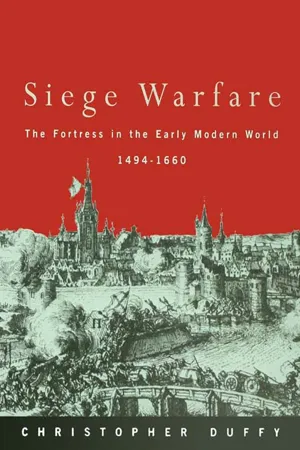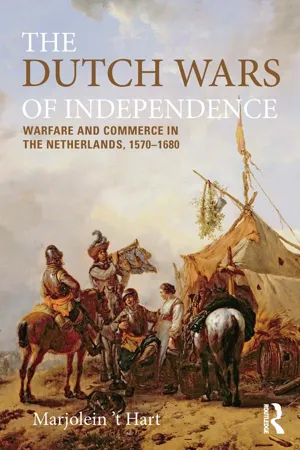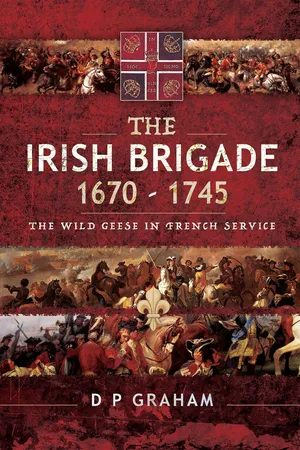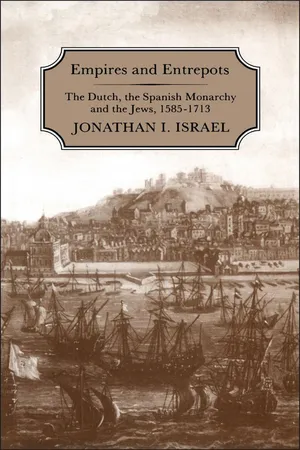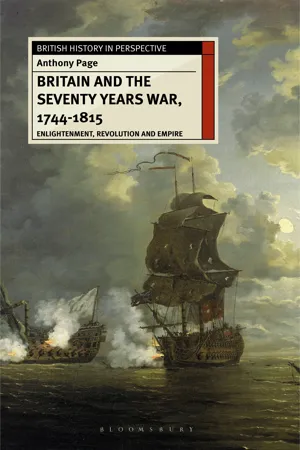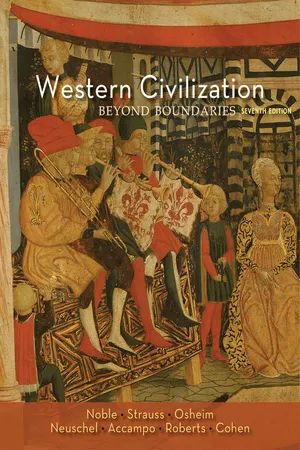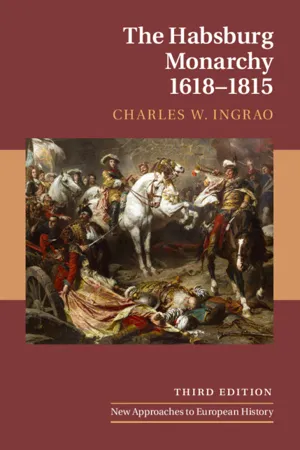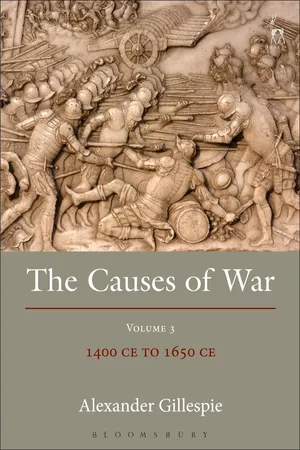History
Eighty Years War
The Eighty Years' War, also known as the Dutch War of Independence, was a protracted conflict between the Spanish Empire and the Dutch Republic from 1568 to 1648. It resulted in the independence of the Dutch Republic and marked a significant shift in the balance of power in Europe. The war also had religious and economic dimensions, with the Dutch Revolt being a key factor in the conflict.
Written by Perlego with AI-assistance
Related key terms
1 of 5
10 Key excerpts on "Eighty Years War"
- eBook - ePub
Siege Warfare
The Fortress in the Early Modern World 1494-1660
- Christopher Duffy(Author)
- 2013(Publication Date)
- Routledge(Publisher)
Four The Eighty Years War in the Netherlands 1566–1648The conditions of the struggle
‘The war in the Netherlands is the biggest, bloodiest and most implacable of all the wars which have been waged since the beginning of the world’ (quoted in Villa, I904, 473). So exclaimed the Spanish councillor of state Fernando Giron in I627, when the war between Spain and the young Dutch state had already lasted sixty years, and still had twenty more to run.This struggle was of the first importance in the history of fortress warfare. These eight decades witnessed not just the further development of the new shapes of fortification which had first evolved in Italy, but the elevation of the siege attack to the status of a science. Such advances were given a European currency, for the Lowlands Wars were considered ‘the nursery of the militia’ (Hexham, 1642–3, dedication).The human interest was also remarkable. The sieges of places like Haarlem and Ostend rivalled the most bitter episodes of the Turkish wars or the Peninsular War in desperate obstinacy, and they outmatched them in active, inventive bravery, which was a much rarer quality.The groundThere are a number of geographical and military constants which go far to explain why the Eighty Years War was fought at such length and with such determination. Most obviously, there was the system of river barriers and associated obstacles — inundations, wastelands, forts and blockhouses — which cramped the movement of the field armies.The Spanish Netherlands of the third quarter of the sixteenth century comprised present-day Holland and Belgium. Dutch nationhood had its roots in the natural redoubt formed by the seaward provinces of Holland and Zeeland. Here the rebels found a secure retreat during the crisis of the revolt in I572 and I573, for - eBook - ePub
The Dutch Wars of Independence
Warfare and Commerce in the Netherlands 1570-1680
- Marjolein 't Hart(Author)
- 2014(Publication Date)
- Routledge(Publisher)
1Military eventsFrom the Dutch Revolt to ‘la Guerre de Hollande’, c. 1570–c. 1680We are destroyers of citadels but builders of free cities.1The war that became known as the Dutch Revolt or the Eighty Years War started as a series of minor revolts in the Low Countries against the lawful overlord, Philip II King of Spain. The movement gained ground as towns and whole provinces allied themselves to the rebels and by the 1580s the Dutch Republic was firmly institutionalized. The military confrontation proved to be extended, lasting many decades – not least because the terrain, by nature already intersected with waters and marshy grounds, was additionally dotted with numerous fortresses and strongly fortified towns. Any military operation in this area was doomed to lose momentum before long; in a couple of months defenders (from either side) were able to regain their strength. That the terrain was stronger than man was shown on numerous occasions: during the Spanish advances of 1573 and 1629 in the north and the Dutch campaigns of 1568 and 1635 in the south, and again in 1672 when the French invasion was forced to stop short at Holland’s provincial borders. Not only the terrain but also the capacities of the belligerents caused the Dutch Wars of Independence to last so long. The Spanish monarchy drew enormous resources from its imperial base, while the Dutch had the advantage of outstanding logistics as part of their war finances and a burgeoning economy. What follows is an overview of the most significant political and military developments, concluded by a summary of the contrasting strategies of the belligerents. The chapter also provides essential context for the other chapters of this book.The Dutch Revolt and the struggle for survival, 1570s to 1580sBeing one of the wealthiest and most urbanized regions of Europe, the Low Countries cherished their ‘liberties and privileges’ under Spanish-Habsburg rule. Emperor Charles V had just united the 17 provinces in 1549 (see Figure 1.1 ). The relationship between the overlord and his subjects was one of fluctuating loyalty and criticism. After the abdication of Charles V, criticism directed against his son Philip II intensified. Like all other major upheavals, the Dutch Revolt was caused by a mix of unstable conditions and highly varied discontent that involved several layers of society at the same time. After repeated large-scale open-air Calvinist sermons and iconoclast outbursts had threatened Catholic rule, the Spanish king sent the Duke of Alva in 1567 as the new governor-general to restore order. Alva was convinced that his work of pacification would be a matter of just a couple of months, not least because of the numerous factional divisions in the Low Countries, but also because the Spanish troops were at that time Europe’s largest, best trained and best equipped military force.2 The duke was known for his ruthless attitude towards his enemies and within a short time his ‘Council of Blood’ had over a thousand of the regime’s ‘adversaries’ executed, among others the counts of Egmond and Hoorn, who belonged to the highest nobility.3 - eBook - PDF
The Irish Brigade, 1670–1745
The Wild Geese in French Service
- D. P. Graham(Author)
- 2020(Publication Date)
- Pen and Sword Military(Publisher)
By the time of the Nine Years’ War, the rivalry between the Bourbons and Spanish Habsburgs was already a symptom of past glories. The new France’s destiny was at stake, and it was fast becoming the chief political and military power on the European stage. That meant that martial prowess, through fair means or foul, in pursuit of dynastic power, had to be shown to be real and effective. The Dutch provinces, on the other hand, had seen a very different emergence and their destiny was less than certain. After the EightyYears’ War with Spain, to define their freedom, which must have been anathema to Louis who saw them as rebels, the Dutch pursued their two primary aims: commercial supremacy through effective trade and a Calvanist Protestantism, whose very concepts flew in the face of France’s Catholic underpinnings. There being no natural boundary between France and the Spanish Netherlands, as there was with Spain itself, almost invited trouble to brew in the area, and for their ownership to be a matter hotly contested. Practically, Dutch efforts to seek a buffer state had helped propagate the 1672 war, and the Treaty of Nijmegen had granted the United Provinces some advantages. Louis wouldn’t forget, however, and continued to intrigue on the European stage, even having a hand in Turkish incursions into Hungary and Austria. German states looked to the rapidly developing League of Augsburg as a means of uniting split factions against a term that might be scarcely whispered, that of a ‘common enemy’. By 1686 William of Orange The End of the Beginning: The Nine Years’ War in Europe 321 and the Elector of Brandenburg were already talking of abandoning their hitherto solid neutrality towards France; it would quickly become antipathy, although the Germanic states were not the only thing on William’s mind. Since Charles II’s restoration in 1660 English foreign policy had been irresolute, and lacked clear strategy. - eBook - PDF
Empires and Entrepots
Dutch, the Spanish Monarchy and the Jews, 1585-1713
- Jonathan Israel(Author)
- 1990(Publication Date)
- Hambledon Continuum(Publisher)
Partly perhaps this may be due to a lingering tendency to regard the conflict as a con-tinuation of the Dutch struggle for independence which, to all intents and purposes, was won by 1609 when the first Spanish-Dutch war ended. A common assumption, at any rate, is that there is an essential continuity between the wars, that the struggle of 1621-48 was merely the second phase of a so-called Eighty Years War in which a declining but incorrigibly obstinate Spain exhausted itself in-* An earlier version of this paper was read to the Dutch History Seminar at the Institute of Historical Research, University of London, January 1976. It is based on research forming part of a long-term project, supported by the Social Science Research Council, on the social and economic context of Spanish-Dutch conflict and rapprochement in the period 1618-60. I should also like to record my gratitude to Professor K. W. Swart and Professor J. H. Elliott for their help and advice with this article. 1 Consulta, 6 July 1622, fo. 5: Archivo General de Simancas, Estado, legajo (hereafter A.G.S. Est.) 2036. 2 Empires and Entrepots effectually striving to suppress the political and religious independence of an increasingly vigorous republic. And this, except perhaps for old-fashioned Dutch patriots, does not constitute a very edifying subject. Nevertheless, there has long been good cause for doubting such an interpretation. Decades ago it was shown that the way in which the Spanish-Dutch rupture was presented publicly in the United Provinces in 1621 was largely determined by domestic political considerations and especially the need to convince the Dutch people of the necessity of a war for which there was enthusiasm only in certain quarters. - eBook - PDF
Britain and the Seventy Years War, 1744-1815
Enlightenment, Revolution and Empire
- Anthony Page(Author)
- 2017(Publication Date)
- Red Globe Press(Publisher)
12 Historians have long thought in terms of an eighteenth-century Anglo-French ‘Second Hundred Years War’ running between 1689 and 1815. 1 Yet there are problems with talking of a Second Hundred Years War that stretches over 125 years. And the conflicts of this period can be better seen in two groups. The Glorious Revolution sparked the Nine Years War/War of English Succession (1689 – 1697) that was soon followed by the War of Spanish Succession (1702 – 1713). Britain during these two decades of war with Louis XIV’s France continues to attract much scholarly attention. 2 The death of France’s Sun King in 1715 was followed by three decades of Anglo-French peace. They were formally allies from 1716 to 1731 – a period in which ‘France’s navy was practically non-existent’. 3 Indeed, as Jonathan Dull has observed, ‘never had Europe seen a period of peace as wide-ranging and long-lasting as that which endured from late 1721 to late 1733’. 4 Thus, in The Wealth of Nations, Adam Smith observed that early eighteenth-century ‘England had enjoyed a profound peace for about eight-and-twenty years’. 5 Historians sometimes date one of the periods of warfare ‘with France, and allies of France’ as 1739 – 1748, which began with Britain’s War of Jenkins’ Ear against Spain and merged with the War of the Austrian Succession. 6 Yet direct war between Britain and France was not declared until March 1744. Though the end of the War of the Austrian Succession brought ‘a few years of uneasy peace in Europe’, in Stephen Conway’s words, ‘Anglo-French hostilities continued almost unabated elsewhere’ until war was again officially declared in 1756. 7 The years following the end of the Seven Years War (1756 – 1763) saw ongoing rivalry in the Caribbean, India and exploration of the Pacific. Rebellion in Britain’s 13 North American Colonies provided France with an opportunity for Chapter 1: The Seventy Years War THE SEVENTY YEARS WAR 13 revenge by providing military assistance to the insurgents. - eBook - PDF
From Reich to Revolution
German History, 1558-1806
- Peter H. Wilson(Author)
- 2019(Publication Date)
- Red Globe Press(Publisher)
2 The term ‘thirty years war’ was already current by 1645, and though a myth, in that the con£ict was not 103 a single, uniform struggle across this time, none the less indicates that contemporaries believed its intensity and duration warranted distin-guishing it from other, parallel wars. 3 A second interpretation emphasises the social and economic problems encountered in the previous chapter, particularly the climatic changes of the Little Ice Age and the tensions stoked by population growth in the later sixteenth century. These problems climaxed in what is labelled the ‘General Crisis of the seventeenth-century’ as the underlying shift towards capitalism triggered a series of violent civil and international wars. 4 Like the ¢rst interpretation, this approach sees the central Euro-pean struggles as part of a broader European phenomenon, but argues they were caused by socio-economic rather than political or religious problems. Contemporaries did blame arms manufacturers and soldiers for prolonging the war, and the need to secure resources certainly pro-pelled Sweden to invade the southern Baltic shore. However, it is di⁄cult to draw a direct connection between the wider socio-economic tensions and the outbreak of war in 1618. It is even harder to ¢nd evidence to support the theory that the con£ict can be interpreted in class terms. Corporate groups like the aristocracy did pursue sectional interests, but they were riven like the rest of society by confessional, dynastic and other loyalties. The role of belief gives rise to the third explanation, which sees the con£ict as a ‘religious war’. The Dutch and Bohemian revolts repre-sented popular challenges to rulers’ claims to religious as well as political sovereignty over their subjects and imparted a sectarian character to the main civil wars. - eBook - PDF
Western Civilization
Beyond Boundaries
- Thomas F. X. Noble, Barry Strauss, Duane Osheim, Kristen Neuschel(Authors)
- 2013(Publication Date)
- Cengage Learning EMEA(Publisher)
Editorial review has deemed that any suppressed content does not materially affect the overall learning experience. Cengage Learning reserves the right to remove additional content at any time if subsequent rights restrictions require it. 418 Chapter 15 Europe in the Age of Religious Wars, 1560–1648 wracked by a war simultaneously religious and political in origin. Regardless of its roots, warfare itself had become more destructive than ever before thanks to innovations in military technology and campaign tactics. Tensions everywhere were also worsened by economic changes, especially soaring prices and unemployment. The political and reli- gious struggles of the era took place against a background of increasing want, and eco- nomic distress was often expressed in both political and religious terms. A period of tension, even extraordinary violence, in political and social life, the era of the late sixteenth and early seventeenth centuries was also distinguished by great cre- ativity in some areas of cultural and intellectual life. The plays of Shakespeare, for exam- ple, mirrored the passions but also reflected on the dilemmas of the day and helped to analyze Europeans’ circumstances with a new degree of sophistication. Imperial Spain and the Limits of Royal Power What circumstances permitted Spain’s ambitious policies and to what degree were they successful? To contemporary observers, no political fact of the late sixteenth century was more obvi- ous than the ascendancy of Spain. Philip II (r. 1556–1598) ruled Spanish conquests in the New World, as well as wealthy territories in Europe, including the Netherlands and parts of Italy. Yet imperial Spain did not escape the political, social, and religious turmoil of the era. Explosive combinations of religious dissent and political disaffection led to revolt against Spain in the Netherlands. - eBook - PDF
A Global History of War
From Assyria to the Twenty-First Century
- Gérard Chaliand(Author)
- 2014(Publication Date)
- University of California Press(Publisher)
However, the defeat of the Spanish Armada reduced Spanish pressure on the Netherlands at a time when the House of Orange had an invalu-able leader in Maurice of Nassau. He paid his troops punctually but Overview | 35 demanded strict discipline and rigorous training. On the battlefield, his troops proved tactically superior to the Spanish and developed improved siegecraft that enabled them to take previously impregnable fortresses. Nassau won the battle of Nieuwpoort (1600) with innovative tactics and siegecraft, which may have been of greater importance than the outcome of the battle itself. The rebels recaptured their cities, and the war ended with a truce. The seven Protestant United Provinces became independent, while the southern Netherlands, present-day Belgium, remained Catholic. Europe was at peace for nine years before the Thirty Years’ War, the most murderous war in its history until the twentieth century. The Hapsburgs, backed by the power of Spain and Portugal, sought to crush the German Protestants. The Hapsburg Holy Roman emperor Charles V was king of Spain and was married to Isabella of Portugal. However, Catholic France didn’t wish to see the Hapsburgs’ power increase and joined with Protestant Sweden to oppose them. Bohemia, Denmark, England, and the United Provinces also sided against the empire. The musket, introduced in the sixteenth century, had improved: it was still slow to shoot, requiring a hundred movements to reload, but had become efficient at distances of over two hundred yards. It could be discharged twice a minute and was heavy enough to require a support-ing post. The Swedish king Gustavus Adolphus, a major figure in the Thirty Years’ War, reorganized his army through a series of reforms to improve mobility. Cavalry was strictly reserved for charging enemy lines. The cavalry would fire their pistols and then charge with their sabers. - eBook - PDF
- Charles W. Ingrao(Author)
- 2019(Publication Date)
- Cambridge University Press(Publisher)
2 The Thirty Years’ War (1618–1648) The Monarchy and the “General Crisis” The difficulties posed by the monarchy’s diversity and exposed central European position preoccupied its rulers throughout its history. These problems were, however, compounded by other challenges that con- fronted it and much of the rest of European society at the beginning of the seventeenth century. Over the past generation most historians have accepted the notion that Europe was then in the throes of a “General Crisis” as it tried to adjust to the dramatic developments that had taken place over the previous century. The economy was changed forever by the dramatic expansion in trade and by the inflation, or “price revolu- tion,” caused by the influx of silver from the New World. Europe had heretofore had a predominantly barter- and subsistence-oriented agrar- ian economy controlled by landowning nobles but worked by their peasant labor force. It now began slowly converting to a money- and market-oriented economy controlled by the bourgeoisie and other capit- alist elements seeking higher profits from trade and industry, as well as from agriculture. International relations were revolutionized by the sudden emergence of the new Habsburg global empire and the almost perpetual wars between it and its two natural enemies, France and the Ottoman empire. The need to feed the resulting arms race transformed domestic politics into a struggle between rulers and their people over the power to tax. Finally, the monarchs’ concern for the security of their realms extended to their growing insistence on religious uniformity among their subjects, lest the growth of heresy inspire rebellion or civil war. The Austrian Habsburg monarchy faced all of these problems by the opening decades of the seventeenth century. The Economic Crisis As they entered the seventeenth century the Habsburgs needed to gain greater control over taxation, but first had to decide on whose shoulders 24 - eBook - PDF
The Causes of War
Volume III: 1400 CE to 1650 CE
- Alexander Gillespie(Author)
- 2017(Publication Date)
- Hart Publishing(Publisher)
When Spain arrested 154 The Culmination: The Thirty Years’ War 58 Lesaffer, R (2006) ‘Defensive Warfare, Prevention and Hegemony: The Justifications for the Franco-Spanish War of 1635’, Journal of the History of International Law 8, 91–123, 141–79; Parker, G (2013) Global Crisis: War, Climate and Catastrophe in the Seventeenth Century (New Haven, CT, Yale University Press) 32. 59 Grant, R (2011) 1001 Battles (London, Penguin) 320, 334, 335, 336, 337, 340, 341, 344. 60 ‘The 1641 Treaty of Alliance Between Portugal and France’ and the ‘1641 Treaty of Truce and Commerce Between the United Netherlands and Portugal’ in Davenport, F (ed) (1917) European Treaties Bearing on the History of the United States and its Dependencies to 1648 (NYC, Carnegie Institute) 324–46; Curtis, B (2013) The Habsburgs (London, Bloomsbury) 125–29; Seward, D (2013) The Bourbon Kings of France (London, Jones) 60–63. the Bishop of Triers, who was under French protection, Louis XIII had the excuse he needed to declare war on Spain, mobilising 150,000 men in 1635. To bolster the anti-Habsburg effort, the French renewed their alliances with the Dutch and then increased their subsidies to the Swedes (first under the Treaty of Wismar of 1636 and later under the Treaty of Hamburg of 1641), promising 1,000,000 livres , about one-third of Sweden’s domestic income, if the Swedes remained engaged in the fight and followed French direction, continuing to fight in Silesia and Bohemia. 58 The Habsburgs retaliated swiftly. In the middle of 1636, imperial troops invaded Burgundy, while a Spanish army attacked Picardy. It advanced across the Somme, only to find its advance blocked by some 40,000 French troops commanded by Louis XIII, standing between the Spanish and Paris. Thereafter, the tide turned. Victory after victory followed for the French and Dutch, with them retaking Breda in 1637. In 1638, an imperial army was destroyed at Rheinfelden, thus allowing most of Alsace to be con-quered.
Index pages curate the most relevant extracts from our library of academic textbooks. They’ve been created using an in-house natural language model (NLM), each adding context and meaning to key research topics.
